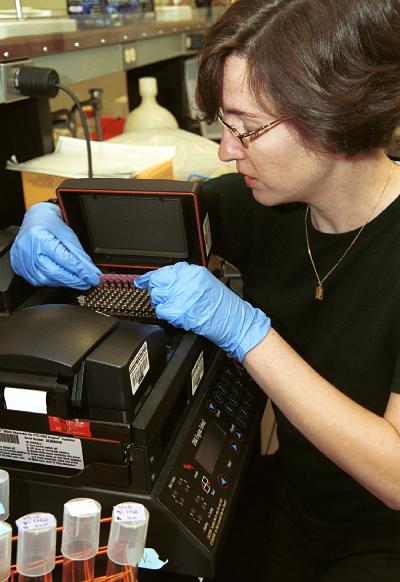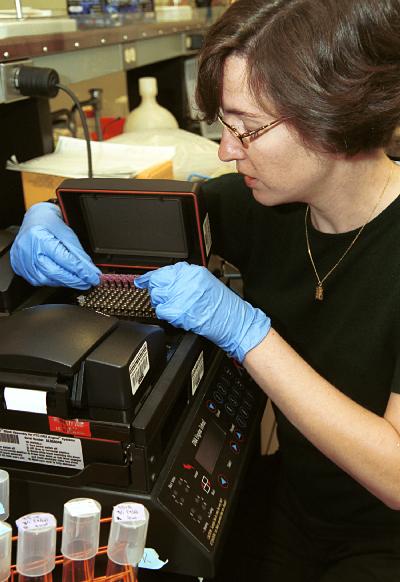August 21, 2003
Mysterious organisms dominate Earth’s oceans, researchers find
They are the Earth’s tiniest organisms capable of photosynthesis and, because there are so many of them, they alone are responsible for two-thirds of the carbon absorbed by the world’s oceans each year from carbon dioxide in the atmosphere.
Now scientists have published the genetic blueprints for four closely related forms of these cynobacteria, marine microbes able to turn sunlight and carbon into living biomass like plants do. Mapping the genomes will help scientists understand the behavior of these organisms, which are too small to identify even with the most powerful microscopes, and how they might react en masse to changes in the amount of sunlight and temperatures as a result of global climate change.
The sequencing of the genomes of three strains of Prochlorococcus and one of closely related Synechococcus was reported in the August 13 online issues of Nature and the Proceedings of the National Academy of Sciences.
“The four that have been sequenced represent numerous strains that populate ocean waters and form the base of the food web,” said Gabrielle Rocap, a UW assistant professor of oceanography and lead author of the Nature paper reporting the genetic blueprints for two Prochlorococcus strains.
“A hundred of these organisms can fit end-to-end across the width of a human hair,” Rocap said, “but they grow in such abundance that, as small as they are, they at times amount to more than 50 percent of the photosynthetic biomass in the oceans.”
“These cells are not just some esoteric little creatures. They dominate the oceans. There are some 100 million Prochlorococcus cells per liter of seawater, for example,” said Sallie “Penny” Chisholm, professor of civil and environmental engineering at the Massachusetts Institute of Technology. Rocap earned her doctorate from the MIT-Woods Hole Joint Program in 2000.
In the same issue of Nature, a team led by Brian Palenik of the Scripps Institution of Oceanography, University of California-San Diego, reported the sequence of Synechococcus, a co-inhabitant of ocean waters with Prochlorococcus. Another paper, written by a team led by Frederick Partensky, Centre National de la Recherche Scientifique, Station Biologique de Roscoff, France, describes the genome of a third strain of Prochlorococcus and was published in the Proceedings of the National Academy of Sciences.
The paper with Rocap as lead author reports the genetic sequences for two different Prochlorococcus strains, then compares them. The two strains were known to differ in their DNA sequence for the ribosomal RNA gene by less than 3 percent, which might normally prompt scientists to lump them as a single species. However, Rocap said there were distinct differences between the two in such things as the light intensity required for optimum growth, pigmentation, light-harvesting efficiencies, ability to use nitrogen and sensitivity to trace metals.
The detailed comparison between the genomes of the two Prochlorococcus ecotypes revealed many of the genetic foundations for differences that allow them to thrive at different depths in the ocean’s surface waters, Rocap says.
“The idea is to let the organisms tell us what dimensions of their environment are important in determining their distribution and abundance,” Chisholm said. “And this will become easier and easier as the genomes of additional strains are sequenced, and the functions of the genes are understood.”
Rocap said, “Right now we don’t even know the range of diversity that exists. We’ve just had a glimpse of the different genome types that are out there.” As more is known it will become easier to predict how these organisms might react to such things as climate change, an important consideration because of their effect on biogeochemical cycles in the oceans.
Other authors of the Rocap paper include Nathan Ahlgren, a UW graduate student in oceanography, additional authors from MIT, and from Oak Ridge National Laboratory, the Joint Genome Institute, Lawrence Livermore National Laboratory, Humboldt University in Germany, Interuniversity Institute of Marine Science in Israel and Woods Hole Oceanographic Institution.
The research was sponsored by the U.S. Department of Energy, National Science Foundation, Seaver Foundation, Israel-U.S. Binational Science Foundation and FP5-Margenes.
Raymond Orbach, director of the Department of Energy’s Office of Science, said, “While many questions remain, it’s clear that Prochlorococcus and Synechococcus play an immensely significant role in photosynthetic ocean carbon sequestration. Having the completed genome in hand gives us a first — albeit crude — ‘parts list’ to use in exploring the mechanisms for these and other important processes that could be directly relevant to this critical DOE mission.”
“This research addresses in a concrete way major questions in biological oceanography, at levels finer than the species level,” said Phil Taylor, director of NSF’s biological oceanography program, which also funded part of the research. “The work shows there is a rich and fascinating diversity of physiological capacity and adaptation in the sea, and that this diversity is not always revealed by looking in the microscope.”




